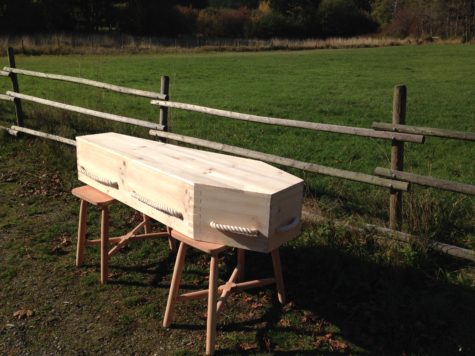Protecting the Land and Honouring the Dead
The practice of natural burial returns the body to the ground in its natural state. As a result this approach avoids using embalming fluid, metals and synthetic fabrics, all of which contaminate the natural environment. As well, natural burial honours the dead by avoiding the invasive procedures used in conventional funeral practices.
Embalming uses a variety of preservatives, disinfectants and restoratives intended to slow decomposition of the body and promote a life-like appearance. Concerns relating to embalming focus mainly on the impact of toxic compounds such as formaldehyde seeping into the groundwater. With natural burial, the body can be preserved for a considerable time through the use of refrigeration and/or dry ice.
A body prepared for natural burial can be dressed in clothing as long as it is totally biodegradable, which means no hooks or zippers, plastic buttons, synthetic fibers (even within such things as elastic) or other non-degradable items. It is simpler, however, to clothe the body in a quilt or plain gown prepared specially for burial and/or a shroud made of a natural material such as cotton, wool or linen. Although the aim is to avoid burying non-biodegradable material, it is generally considered neither practical nor ecologically important to remove foreign material such as dental fillings, artificial heart valves or artificial hips before burial.
 Totally biodegradable pine coffin made on Denman Island
Totally biodegradable pine coffin made on Denman Island
A closed, rigid container is required by law for the safe transfer of human remains. Natural burial requires that, to be buried, this container must be made of biodegradable materials. Today, one can purchase coffins made of cardboard or willow, as well as simple handmade boxes made of untreated wood. No metal fasteners such as metal hinges, screws and/or nails are allowed in containers used in the Denman Island Natural Burial Cemetery
Graves in a natural burial ground are not as deep as traditional graves, in order to promote natural decomposition, and are not supported by a vault (i.e., a concrete or metal grave liner). The settling of the earth within a grave (subsidence) is anticipated and is not a concern from the viewpoint of cemetery maintenance. In addition, graves are not marked by a tombstone or plaque, although some natural burial grounds, including the Denman Island Natural Burial Cemetery, allow a small indigenous stone to be placed as a marker at the time of the burial.
The decision to use natural burial for after-life care is usually made well in advance of one’s death and includes finding a cemetery that provides natural burial. People making this choice are well advised to document their plans, so their heirs, attorney and estate planner can know of their wishes ahead of time.
